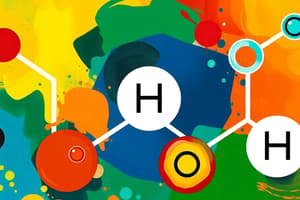Podcast
Questions and Answers
What principle distinguishes ionic bonding from covalent bonding?
What principle distinguishes ionic bonding from covalent bonding?
- Ionic bonding arises from the transfer of electrons between atoms. (correct)
- Ionic bonding involves the sharing of electrons.
- Covalent bonding creates charged ions.
- Covalent bonding typically occurs between metals and nonmetals.
Which aspect of chemical reactions does stoichiometry primarily focus on?
Which aspect of chemical reactions does stoichiometry primarily focus on?
- The role of catalysts in speeding up reactions.
- The qualitative analysis of reactants and products.
- The energy changes that occur during reactions.
- The quantitative relationships between reactants and products. (correct)
Which type of bond is most commonly associated with the sharing of pairs of electrons between atoms?
Which type of bond is most commonly associated with the sharing of pairs of electrons between atoms?
- Ionic bond
- Covalent bond (correct)
- Metallic bond
- Hydrogen bond
What is the primary function of electrochemical cells?
What is the primary function of electrochemical cells?
How does statistical mechanics contribute to the understanding of macroscopic systems?
How does statistical mechanics contribute to the understanding of macroscopic systems?
What determines the chemical reactivity of an organic molecule?
What determines the chemical reactivity of an organic molecule?
Which of the following types of hydrocarbons contains at least one double bond?
Which of the following types of hydrocarbons contains at least one double bond?
In coordination chemistry, what interacts with transition metals to form complexes?
In coordination chemistry, what interacts with transition metals to form complexes?
What is the main focus of physical chemistry?
What is the main focus of physical chemistry?
The study of energy transformations within chemical systems is known as what?
The study of energy transformations within chemical systems is known as what?
Stereoisomers differ in what aspect?
Stereoisomers differ in what aspect?
Which of the following is NOT a characteristic of aromatic compounds?
Which of the following is NOT a characteristic of aromatic compounds?
Which chemical process involves the transfer of electrons?
Which chemical process involves the transfer of electrons?
Flashcards
Spectroscopy
Spectroscopy
Using electromagnetic radiation to study the structure and properties of molecules and atoms.
Electrochemistry
Electrochemistry
Study of the relationship between electricity and chemical reactions, including cells and batteries.
Quantum Chemistry
Quantum Chemistry
Using quantum mechanics to understand chemical processes, especially bonding.
Atomic Structure
Atomic Structure
Signup and view all the flashcards
Chemical Bonding
Chemical Bonding
Signup and view all the flashcards
Organic Chemistry
Organic Chemistry
Signup and view all the flashcards
Functional Groups
Functional Groups
Signup and view all the flashcards
Isomerism
Isomerism
Signup and view all the flashcards
Inorganic Chemistry
Inorganic Chemistry
Signup and view all the flashcards
Coordination Chemistry
Coordination Chemistry
Signup and view all the flashcards
Thermodynamics
Thermodynamics
Signup and view all the flashcards
Chemical Kinetics
Chemical Kinetics
Signup and view all the flashcards
Physical Chemistry
Physical Chemistry
Signup and view all the flashcards
Study Notes
Organic Chemistry
- Organic chemistry is the study of carbon-containing compounds, including their structures, properties, reactions, and preparation.
- Carbon's unique ability to form covalent bonds with other carbon atoms and elements such as hydrogen, oxygen, nitrogen, and halogens leads to a vast array of molecules.
- Key concepts include:
- Functional groups: Specific groups of atoms within molecules that determine their chemical reactivity. Examples include hydroxyl (-OH), carboxyl (-COOH), amino (-NH2), and carbonyl (-C=O) groups.
- Isomerism: Molecules with the same molecular formula but different structures. Stereoisomers have different spatial arrangements.
- Alkanes, alkenes, alkynes: Different classes of hydrocarbons differing in the type of carbon-carbon bonds.
- Aromatic compounds: Cyclic structures with delocalized pi electrons (e.g., benzene).
- Reaction mechanisms: Detailed descriptions of how reactions proceed, involving steps like bond breaking and formation.
- Organic synthesis: Designing and executing chemical reactions to produce specific target molecules.
- Applications span pharmaceuticals, materials science, and more.
Inorganic Chemistry
- Inorganic chemistry focuses on the synthesis, structure, properties, and reactions of elements and compounds other than hydrocarbons.
- Includes minerals, metals, and inorganic complexes.
- Key areas include:
- Coordination chemistry: Study of complexes formed by transition metals with ligands (molecules that bind to the metal).
- Metal-organic frameworks (MOFs): Inorganic structures with organic linkers, showing potential in gas storage and catalysis.
- Acids and bases: Reactions involving protons (H+) and hydroxide ions (OH-).
- Redox reactions: Reactions involving electron transfer.
- Crystallography: Understanding the arrangement of atoms in solids.
- Periodicity: Trends in properties of the elements across the periodic table.
- Important for materials science, biochemistry, and industrial processes.
Physical Chemistry
- Physical chemistry combines chemistry with physics to investigate the physical principles underlying chemical phenomena.
- Key areas include:
- Thermodynamics: Study of energy and its transformations in chemical systems. Includes concepts like enthalpy, entropy, and Gibbs free energy.
- Kinetics: Study of the rates of chemical reactions and the factors affecting them (like temperature, concentration, and catalysts).
- Spectroscopy: Using electromagnetic radiation to study the structure and properties of molecules and atoms.
- Electrochemistry: Study of the relationship between electricity and chemical reactions. Electrochemical cells and batteries.
- Quantum chemistry: Understanding chemical processes using quantum mechanics, particularly important for bonding.
- Statistical mechanics: Using probability to describe the properties of macroscopic systems from the microscopic viewpoint.
- Provides insights into the nature of chemical bonds, reaction mechanisms, and the behavior of matter under various conditions.
General Chemistry
- Underlying principles and concepts common to all branches of chemistry.
- Covers fundamental ideas in:
- Atomic structure: The organization of protons, neutrons, and electrons within atoms.
- Periodic table: Organization of elements based on atomic structure and properties.
- Chemical bonding: Forces holding atoms together in molecules and compounds (e.g., ionic, covalent, metallic).
- Stoichiometry: Quantitative relationships between reactants and products in chemical reactions.
- States of matter: Properties of solids, liquids, and gases, and phase transitions between them.
- Solutions: Homogenous mixtures of solutes and solvents.
- Acids and bases: Concepts of acidity and basicity (pH).
- Provides a foundational understanding for more specialized areas of chemistry.
Studying That Suits You
Use AI to generate personalized quizzes and flashcards to suit your learning preferences.




